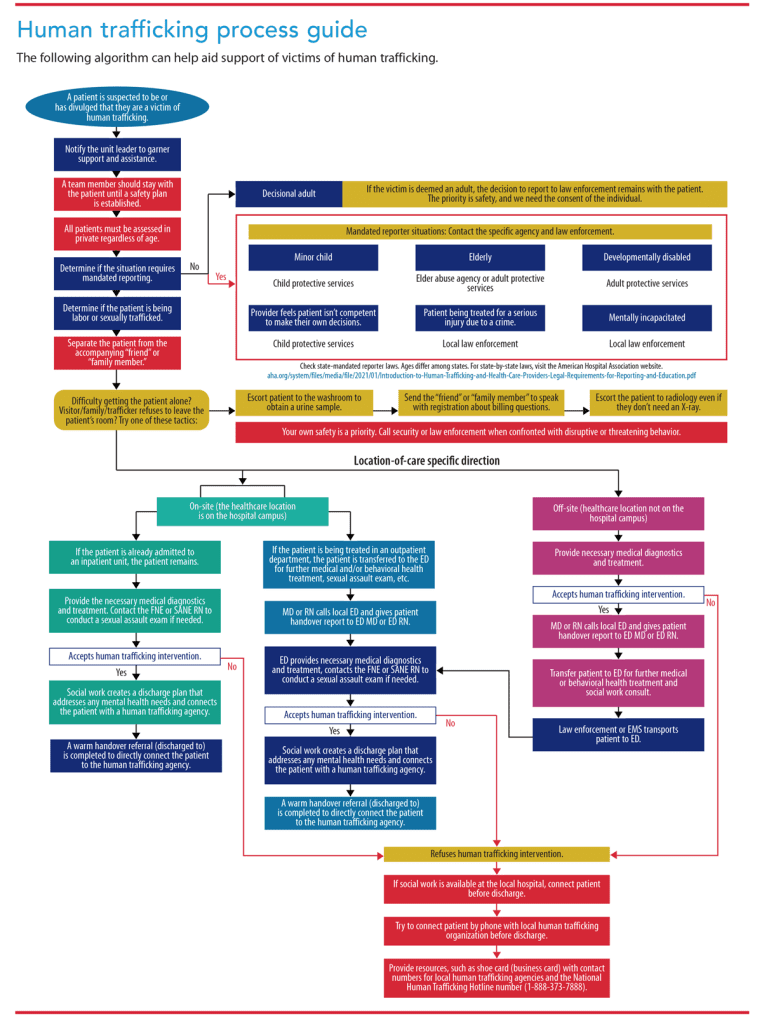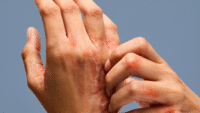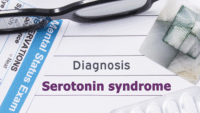Learn how to manage a sensitive situation
- In the United States, between 100,000 and 300,000 people are being human trafficked.
- Over half of survivors of labor and sex trafficking had accessed healthcare at least once during their ordeal, but as much as 97% didn’t receive human trafficking information or resources.
- Survivors of human trafficking report that they want healthcare professionals to actively listen, provide physical and emotional safety, and offer understanding and compassion.
- Describe how to recognize and interact with a victim of human trafficking.
- Identify techniques to communicate as a first responder to a victim of human trafficking.
- Describe appropriate actions once you’ve identified a victim of human trafficking.
No relevant financial relationships were identified for any individuals with the ability to control content of the activity.
Expiration: 7/1/27
The growth of human trafficking (second only to drug trafficking in global criminal enterprises) increases the odds that you’ll encounter a patient who’s a victim. The Department of Homeland Security estimates that as of 2021 over 30 million people were enslaved around the world; in the United States, between 100,000 and 300,000 people are currently being human trafficked. According to the U.S. Department of State, finding reliable statistics remains difficult because the quality and quantity of available data frequently are hampered by the hidden nature of the crime, challenges in identifying individual victims, gaps in data accuracy and completeness, and significant barriers regarding the sharing of victim information among various stakeholders. For these reasons, data and statistics may not reflect the full nature or scope of the problem. (See What is human trafficking?)
Human trafficking: Preparing for a unique patient population
What is human trafficking?
Simply put, human trafficking is the exploitation of people for money. The U.S. Department of Justice defines human trafficking as the act of recruiting, harboring, moving, or obtaining a person by force, fraud, or coercion for the purpose of involuntary servitude, debt bondage, or sexual exploitation. All children under the age of 18 who perform commercial sex acts are victims of trafficking, even if they’re not coerced. Labor trafficking, a form of human trafficking in which individuals perform labor or services, includes situations of debt bondage, forced labor, and involuntary child labor. Other forms of human trafficking include human organ trafficking, forced marriage, child marriage, and child soldiers.
The classic 2014 Annals of Health Law study noted that over 88% of sex trafficking survivors reported that they sought healthcare in various settings while being trafficked. Many victims receive care from unqualified individuals. A 2017 study by the Coalition to Abolish Slavery and Trafficking noted that over half of survivors of labor and sex trafficking had accessed healthcare at least once during their ordeal, but as much as 97% didn’t receive human trafficking information or resources.
Why do so many victims of trafficking never receive intervention assistance? Primarily because they hide in plain sight. Healtrafficking.org defines healthcare professionals as first responders. We’re responsible for recognizing patients at risk for trafficking, treating their health issues, and providing them with appropriate resources and referrals. We must take the time to educate ourselves so we can detect human trafficking red flags and ask the right questions to confirm who’s at risk. (See Red flags.)
Red flags
Learn the 10 red flags of human trafficking so you can help identify victims.
- The patient’s clinical presentation and oral history don’t match.
- The patient’s oral history feels scripted, memorized, or mechanical.
- Someone with the patient exerts an unusual amount of control over the visit.
- The patient appears fearful, anxious, depressed, submissive, hypervigilant, or paranoid.
- The patient expresses concern about being arrested or jailed.
- The patient expresses concern about their family’s safety.
- You detect evidence of lack of care for prior or existing conditions.
- Tattoos or insignia on the patient’s body indicate ownership.
- The patient has injuries or ailments linked to their work.
- The patient has sexually transmitted infections.
©Used with permission of the American Hospital Association.
We can’t afford to miss any opportunity to provide aid to this vulnerable population. The average life span of a victim of trafficking is only 5 to 7 years. According to the U.S. Department of State, victims of trafficking frequently suffer serious physical abuse and neglect, experience drug overdoses, die by suicide, or are murdered. Your rapid assessment of the situation and immediate interventions can save a life.
Who can be trafficked?
Anyone can become a victim of trafficking. Victims come from all socioeconomic levels, ages, races, sexual orientations, gender identities, religions, education levels, and ethnicities. Individuals at highest risk include those with limited English proficiency, undocumented workers, participants in visa programs, and those displaced by war. Other high-risk individuals include those experiencing homelessness or struggling with mental health conditions, disabilities, or substance abuse issues; victims of intimate partner violence or child sexual abuse; runaway youth or youth who feel they don’t fit in; children in foster care; and members of the LGBTQ+ community. Especially high-risk individuals (those new to a country who may not know their legal rights and those with a traumatic home life they want to escape) are among the easiest to groom, force, trick, or coerce into a trafficking situation.
Who are the traffickers?
Just like victims of human trafficking, traffickers come from all demographic backgrounds. Some act alone, and some work as part of an organized criminal enterprise. They can be business owners, gang members, diplomats, pimps, and farm or factory owners. They can be male or female, significant others, parents or other family members, or people posing as such. Nearly half of all child trafficking cases involve a family member. The motivation to obtain money or drugs to support an addiction can prove powerful.
Polaris describes some of the methods traffickers use to coerce victims, including physical violence, threats, false promises of employment or marriage, and as part of demanding payment +search for victims via websites and social media, at business establishments within the local community, or through personal interactions with others. Repeatedly selling a person provides the trafficker with limitless financial gain.
Caring for victims
The thought of caring for a patient who’s a victim of human trafficking may seem daunting. Consider it as similar to caring for patients who’ve experienced domestic or intimate partner violence, child sexual abuse, or physical or sexual assault. Survivors of human trafficking report that they want healthcare professionals to actively listen, provide physical and emotional safety, and offer understanding and compassion.
To avoid re-traumatizing victims, limit the number of times they retell their story, provide reassurance, sit at eye level when speaking, establish good eye contact, build trust and rapport, stay sensitive to power dynamics, avoid judgmental or labeling language, let the patient choose treatment, and include them in the plan of care. If possible, provide the patient with a warm soft blanket or stuffed animal and offer food and an opportunity to bathe or shower.
Victims of human trafficking find themselves in incredibly hopeless circumstances. They feel stressed, fearful, highly controlled, and traumatized. Experiencing trauma can result in mistrust of the healthcare system. Anticipate that their reactions probably won’t be the same as that of an average patient. A simple request to put on a gown for an exam could trigger anger, fear, tears, or even an elopement attempt. A lack of eye contact when focused on typing notes can give the impression that you don’t care. A quick touch to the shoulder or even the application of a blood pressure cuff without asking permission could result in panic or aggression.
Many patients won’t disclose what’s happening to them if they’re not asked directly. In other words, if you don’t ask basic questions, such as “Are you safe at home?” or “Is anyone physically harming you?”, you don’t invite the patient to share their experience. If you appear judgmental or unsympathetic, patients may shut down, get angry, stop cooperating with treatment, or insist on leaving.
Trauma-informed care
Using a trauma-informed care approach can help meet the needs of victims of human trafficking. Hopper and colleagues define trauma-informed care as a strengths-based framework grounded in an understanding of and responsiveness to the impact of trauma. It emphasizes physical, psychological, and emotional safety for providers and survivors, and it creates opportunities for survivors to rebuild a sense of control and empowerment.
The Substance Abuse and Mental Health Services Administration explains that using a trauma-informed care approach shifts how we think about the impact of trauma. It doesn’t blame the individual for behaviors they use as coping mechanisms. Rather than reacting to the “bad” behavior (use of foul language, aggression, tears, uncooperativeness) by asking “What’s wrong with you?” ask, “What happened to you?” And rather than highlighting what’s not right or good in the individual, focus on what you can do in the moment to support a move toward healing.
Taking action
Human trafficking requires an interprofessional approach to optimize patient care and resources. The Human Trafficking Process Guide provides frontline nurses, nurse leaders, and others on the healthcare team (no matter the setting) with an algorithm they can use from the initial encounter with a suspected victim through discharge. Whether the patient has divulged that they’re being trafficked or you suspect it based on objective and subjective assessments, the initial steps remain the same. (See Human trafficking process guide.)
Safety first
As soon as you know or suspect that a patient is a victim of human trafficking, notify your unit leader, then take steps to maintain safety. Never put yourself in harm’s way. If you’re confronted with disruptive or threatening behaviors, call your security team or local law enforcement. Also ensure the patient’s physical safety. Traffickers can be dangerous and violent. Consider having someone from your team stay with the patient until establishing a definitive safety plan.
Assess all patients in private regardless of their age. Stay alert, and don’t assume any individual accompanying the patient is acting in their best interest. Separate the patient from the other person, who may present themselves as a friend, significant other, relative, or employer. This individual may not let the patient speak for themselves, refuse to allow for privacy, or insist on providing interpretation if the patient doesn’t speak English. Only use a professional certified interpreter. You want to ensure accurate communication between the patient and yourself.
If the patient arrives alone, watch for constant texting behaviors, which may indicate that the trafficker is checking on the victim to determine their location and what’s being discussed. From afar, the traffickers maintain control over the victim.
If the trafficker accompanies the patient, moving to a private location may prove challenging. To avoid tipping off the trafficker, consider escorting the patient to the restroom to obtain a urine specimen, sending the companion to speak with registration about billing questions, or escorting the patient to radiology even if the patient doesn’t need an x-ray.
Once you and the patient are in a safe area, begin your conversation. Avoid asking outright if they’re being trafficked. Many victims don’t know about human trafficking or recognize it as their current situation. Instead ask specific questions, such as “Have you been physically hurt by anyone?” “Do you have a bed to sleep in at night?” or “Have you been asked to lie about the work that you do?” (See Ask the right questions.)
Ask the right questions
Asking the right questions can help identify a victim of human trafficking.
- Has someone ever denied you possession of your own identification (driver’s license, travel documents)?
- Has someone physically hurt you?
- Has anyone threatened or tried to hurt your family?
- Have you ever stayed in a dangerous situation to protect someone else?
- Has anyone ever threatened or hurt you when you tried to leave your situation?
- Can you come and go as you please?
- Do you have your own spending money?
- Can you freely contact your family and friends and spend time with them?
- Are you being forced to live where you work or somewhere dictated by the person in charge?
- Can you choose where you want to live?
- Do you sleep in a bed?
- Do you have to ask permission to eat, sleep, or use the bathroom?
- Are the doors and windows locked where you stay so that you can’t get out?
- Have you ever been tricked or trapped in an unwanted job or situation?
- Have you ever been forced or threatened into making money for someone else?
- Are you being forced to do something to repay a personal debt?
- Have you been asked to lie about the work you do?
Mandated reporting, law enforcement notification
Not all trafficking situations require mandatory reporting, so nurses, as mandated reporters, must know how to make that determination.
If the patient is an adult, begin by assessing whether they have decision-making capacity. Can they understand relevant information? Can they comprehend the situation they’re in and its potential consequences? Can they reason through the risks, benefits, and alternatives, and then communicate a choice freely and voluntarily?
Ultimately, the decision to report to law enforcement remains with the patient. They must give consent. This may seem counterintuitive, but keep in mind that the trafficker may have told the victim that trying to leave could result in harm to their family or themselves. The trafficker also may have told the victim that contacting authorities could result in arrest or deportation. Similar to domestic violence situations, the most dangerous time for the victim occurs when they try to leave. Respect and abide by the patient’s decision if they refuse a request to call law enforcement. Keeping patients involved in the process reduces the chances of re-traumatization through healthcare professional interference or removal of control over their own decision-making.
However, some instances require immediate reporting. For example, if you’re treating a patient for a serious injury due to a crime or if you or the provider feel that the patient isn’t competent to make their own decisions, you must contact local law enforcement.
Some situations require mandatory reporting to a specific agency in addition to local law enforcement. For example, all states require reporting to state child protective services in addition to local law enforcement in cases of children under age 18 performing commercial sex acts. Trafficking of the elderly (for example in the form of labor in venues such as factories, farming, or domestic work) requires reporting to state adult protective services or elder abuse agency. For adults with developmental disabilities, contact adult protective services. You can learn more about individual state mandatory reporting laws at bit.ly/4bMfVKO.
Physical and mental assessment
Victims of human trafficking can experience both physical and mental conditions, so take a holistic approach that encompasses the mind, body, and spirit. The level of care and number of services available to treat the patient will differ based on the setting where the victim seeks care, but all medical treatment that can be rendered within the scope of that site should be completed.
Use all your senses when caring for victims of human trafficking. What you see, smell, hear, and touch will help ensure that you don’t miss anything. You’ll need to gain the patient’s trust so that you can examine them thoroughly; clothing can easily hide and disguise many physical findings.
Traffickers typically withhold food, appropriate clothing, and medical care from their victims. You may observe poor hygiene if they haven’t been allowed to shower, brush their teeth, or change their clothes for an extended period. They also may appear exhausted because of forced labor (in some cases 12 to 14 hours per day).
Look for signs of physical abuse or unexplained injuries such as bruising, burns, cuts or wounds, broken teeth or bones, and signs of torture. You also may observe the effects of prolonged exposure to extreme temperatures or industrial or agricultural chemicals. Some victims may have a traumatic brain injury, headaches or migraines, unexplained memory loss, insomnia, and difficulty concentrating. Stress reactions can cause or worsen arrhythmias, hypertension, respiratory distress, irritable bowel syndrome, and constipation. You also may notice severe weight loss or malnutrition.
Many victims of human trafficking experience frequent urinary tract infections and other genitourinary issues, including recurrent sexually transmitted infections, genital trauma, retained foreign bodies, repeated unwanted pregnancies, and forced or pressured abortions. Out of fear of being judged, the patient may choose not to disclose accurate numbers of sexual encounters or procedures.
Some trafficking victims have highly visible tattoos, which signify ownership. Popular tattoos include crowns, dollar signs, chains, “property of,” and bar codes. In some cases, the bar code tattoo can lead a trafficker who finds a runaway victim back to the original “owner” where they’re resold. Some traffickers brand their victims like livestock.
Don’t hesitate to ask about tattoos, but keep your questions open-ended. For example, ask, “What does that tattoo mean or represent?” Don’t offer your opinion or impression of what the tattoo looks like or means to you.
Carefully assess the patient for mental health conditions. Many victims of human trafficking experience depression, suicidal ideation, anxiety, self-harming behaviors, feelings of guilt or shame, post-traumatic stress disorder, hostility, lack of emotional responsiveness, fear, withdrawal, and feeling detached from themselves.
Interprofessional care
Most hospitals offer interprofessional services (social work, behavioral health counselors, trauma recovery counselors, care management) to address the needs of victims of human trafficking. However, many urgent care centers, outpatient clinic settings, provider offices, or outpatient testing centers don’t have those resources. For example, they might not be able to offer an official sexual assault examination performed by a forensic nurse examiner or sexual assault nurse examiner for a patient who’s experienced sexual exploitation.
If a patient chooses to accept help when visiting a setting that doesn’t reside on a hospital campus and has limited resources, consider transferring them to the local emergency department (ED) via law enforcement or an ambulance. Discourage the patient from driving themselves or having someone else drive them to the ED. If the setting resides on a hospital campus, escort the patient to the ED in a wheelchair. To ensure safety, enlist security to accompany the patient and team member.
A smooth handoff requires that the sending clinician provide a thorough report to the receiving clinician. Explain the human trafficking situation, treatment already completed, and further healthcare needs. Advance notice and report to the ED will allow them time to prepare for the patient’s arrival so they don’t have to sit in the general waiting room. You’ll want to immediately settle them into a treatment area to ensure privacy and to prevent the trafficker from knowing the victim’s location.
Discharge planning, resource referrals
After addressing the patient’s physical and mental health needs, call the individual within your organization (social worker, trauma recovery team, or care manager RN) responsible for conducting a warm handover referral (discharge planning and connecting the victim of human trafficking with the appropriate governmental agency). This process links the victim directly with the human trafficking service providers via a personal introduction, which creates a sense of safety that encourages the patient to accept help.
Human trafficking agencies may offer emergency or long-term housing; some offer both. The agency may encourage the victim to relocate to a different state so they can put some distance between themselves and the trafficker. Ongoing agency support includes addiction and mental health counseling, legal services, transportation, education, and job training. Depending on the agency, victims can participate in these programs for 1 to 3 years so they have an opportunity to re-enter society, learn how to support themselves, and regain a sense of worth and purpose.
Some victims of human trafficking may decline help. Don’t judge; instead, put yourself in their shoes. Some victims may not even recognize that they’re in a trafficking situation. If they grew up in a violent household or experienced child sexual abuse, they may see their lives as normal. Ongoing physical violence or continuing sexual exploitation may reaffirm to them that they’re good for only one thing. They also may feel that now isn’t the right time to leave the situation. Remember, the most dangerous time for the victim is when they leave.
Some victims develop a powerful psychological bond (trauma bond) with their traffickers. They begin to identify with them, develop trust and affection for them, and even fall in love with them. You might view this as highly irrational, but avoid making negative or derogatory comments about the trafficker. Keeping your focus on the victim can prove a more successful tactic for helping them leave the situation.
If the victim refuses help, encourage them to call a local human trafficking agency. Provide them with the confidential 24/7 National Human Trafficking Hotline number (1-888-373-7888). If available in your organization, give the patient contact information for your social work team or trauma recovery specialists. If the victim also refuses this contact information, provide them with a business card (“shoe” card) with phone numbers for human trafficking agencies to place in their shoe, where a trafficker is less likely to see it. Continue to show support. Remind the victim that you care about their well-being and that the hospital is a safe place.
Open your eyes
Because nurses work in so many settings (hospitals, outpatient clinics, provider offices, public health agencies, community centers, home and long-term care), we’re in an exceptional position to help victims of human trafficking. To ensure we provide the best care possible for these individuals, we must pursue education about human trafficking, victim identification, and appropriate actions. We also must disseminate this information widely to our co-workers, our community, and our families. In addition, victims must have easy access to resources. Consider placing victim brochures and “shoe” cards in examination rooms, waiting rooms, and bathrooms.
By opening our eyes to recognize the signs of human trafficking, we can minimize suffering or even save a life. Together we can work to combat human trafficking.
Dawn Moeller retired in April 2024 after a 38-year career in nursing. She most recently worked as an associate professor in the School of Nursing at Rutgers University in Newark, New Jersey.
American Nurse Journal. 2024; 19(7). Doi: 10.51256/ANJ072406
References
Administration for Children and Families. Adult human trafficking screening tool and guide. January 2018. acf.hhs.gov/sites/default/files/documents/otip/adult_human_trafficking_screening_tool_and_guide.pdf
American College of Obstetricians and Gynecologists. Human trafficking. September 2019. acog.org/clinical/clinical-guidance/committee-opinion/articles/2019/09/human-trafficking
Buck K. Coalition to Abolish Slavery & Trafficking (CAST) responds to 2017 Trafficking in Persons (TIP) Report. July 7, 2017. castla.org/coalition-to-abolish-slavery-trafficking-cast-responds-to-2017-trafficking-in-persons-tip-report
Bureau of Justice Statistics. Human trafficking data collection activities, 2022. October 2022. bjs.ojp.gov/library/publications/human-trafficking-data-collection-activities-2022
Camak DJ. Recognizing and addressing the needs of sex trafficking victims. OJIN: The Online J Issues Nurs. 2021;27(2). ojin.nursingworld.org/table-of-contents/volume-27-2022/number-2-may-2022/articles-on-previously-published-topics/recognizing-and-addressing-the-needs-of-sex-trafficking-victims
Center for Health Care Strategies. 10 key ingredients for trauma-informed-care. August 2017. chcs.org/resource/10-key-ingredients-trauma-informed-care/
Dearnley R. Prevention, prosecution, and protection—Human trafficking. United Nations UN Chronicle. un.org/en/chronicle/article/prevention-prosection-and-protection-human-trafficking
HEAL Trafficking. HEAL Trafficking and Hope for Justice’s Protocol Toolkit. healtrafficking.org/2017/06/protocol-toolkit
Hopper EK. The multimodal sociological (MSE) approach: A trauma-informed framework for supporting trafficking survivors’ psychosocial health. In Chisholm-Straker M, Stoklosa H, eds. Human Trafficking Is a Public Health Issue. New York City, NY: Springer International Publishing; 2017:153-83
Lederer LJ, Wetzel CA. Health consequences of sex trafficking and their implications for identifying victims in healthcare facilities. Ann Health Law. 2014;23:61-91.
Morris G. How nurses can recognize and report human trafficking. March 3, 2023. NurseJournal. nursejournal.org/articles/how-nurses-recognize-and-report-human-trafficking/#:~:text=Practice%20Trauma%2Dinformed%20Care,who%20brought%20in%20the%20patient
National Institute of Justice. Overview of human trafficking and NIJ’s role. October 26, 2022. nij.ojp.gov/topics/articles/overview-human-trafficking-and-nijs-role
Polaris. Recognizing sex trafficking. polarisproject.org/sex-trafficking/
Sabella D. The role of the nurse in combating human trafficking. Am J Nurs. 2011;111(2):29-37. humantraffickinghotline.org/sites/default/files/The_Role_of_the_Nurse_in_Combating_Human%20-%20AJN.pdf
Substance Abuse and Mental Health Services Administration. Trauma-informed care in behavioral health services. Store.samhsa.gov/sites/default/files/sma15-4420.pdf
White House. Fact sheet: The National Action Plan to Combat Human Trafficking (NAP) December 3, 2021. whitehouse.gov/briefing-room/statements-releases/2021/12/03/fact-sheet-the-national-action-plan-to-combat-human-trafficking-nap/
U.S. Department of Homeland Security. Countering human trafficking: Year in review October 2021 to September 2022. January 2023. dhs.gov/sites/default/files/2023-05/23_0131_CCHT_year-in-review_revised-23_0509.pdf
U.S. Department of Justice. What is human trafficking? June 26, 2023. justice.gov/humantrafficking/what-is-human-trafficking
U.S. Department of State. About human trafficking. state.gov/humantrafficking-about-human-trafficking
U.S. Department of State. Policy issues: Human trafficking. 2023. state.gov/policy-issues/human-trafficking
Key words: human trafficking, trauma-informed care, modern-day slavery




















6 Comments. Leave new
‘My patient is a victim of Human Trafficking’ is very well written and is highly informative. I recently completed a required course on Human Trafficking for Texas RN licensure renewal. This course is more comprehensive and is an excellent teaching tool and resource for nurses in all healthcare settings.
well done article
I am nursing faculty in a Technical College. This was a wonderful article. We need more information out there about human trafficking. I plan on sharing this information with my fellow faculty members and students.
Well done
Well done.
this was a very informative article